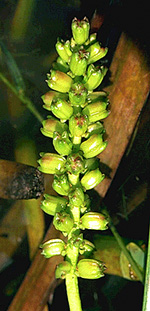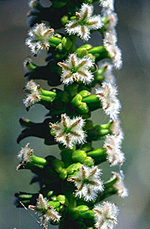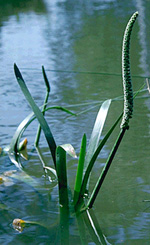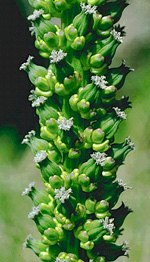 |
This small family is found in temperate lowlands of both Hemispheres. In Australia, most species are found in marshes, rivers and other fresh waterbodies (including in Central Australia); some annual species are characteristic of drying, temporary wetlands or moist areas such as dune swales in quite arid regions.
Characteristic features of the family Juncaginaceae in Australia include: - small sedge-like plants or harge, more robust waterplants with linear, ribbon-like to terete leaves which sheath each other at the base
- flowers small, bisexual, borne in spikes or racemes, with 4-6 green or reddish perianth segments and the same number of stamens
- ovary superior, comprising 2-6 carpels sometimes only partly fused, each with a more or less sessile stigma and developing into a dry fruit that splits to release the seeds, or is indehiscent
Description
Annual or perennial terrestrial herbs, or aquatic herbs rooted in the substrate with their leaves floating or emergent. Perennating by rhizomes. Vegetative reproduction by rhizomes or tubers. Stem internodes solid or spongy or pithy. Internal secretions not obvious. Plants glabrous. Leaves distichous, all or mostly basal, sessile. Stipule-like lobes present or apparently absent. Lamina simple, symmetric, acicular, subulate, linear, lanceolate, ovate, elliptic or oblong; base attenuate or rounded; margins entire, ±flat; venation parallel with the midrib, conspicuous or inconspicuous, and the tertiary venation not reticulate; surfaces not punctate; herbaceous or succulent. Leaf ligule present. Male and female flowers occurring on separate plants, or with all the flowers bisexual. Inflorescences terminal, consisting of racemes. Bracts and bracteoles absent. Pollination by wind. Flowers stalked. Perianth regular, of 2 similar whorls, with (1–) 6 (–8), free, sepaloid segments, imbricate in bud, green, without contrasting markings, herbaceous. Fertile stamens 4 or 6, opposite to and free of or at least partly fused to the perianth segments, free of the ovary and style, distinct from each other, all ±equal. Anthers basifixed, not versatile, opening outwards by longitudinal slits; 2-celled. Ovary superior and sessile. Carpels (2–) 3, 4 or 6 (–8), free from each other or fused; ovary with (1–) 3–6 (–8) locules. Style branching from the base, or absent and the stigma ±sessile. Ovules 1 per locule, sessile; placentation basal or apical. Fruit dry, indehiscent, an achene, or follicle-like (camarium); the perianth on the maturing fruit deciduous. Disseminule macro-surface ribbed, hooked, spurred or winged; micro-surface ±smooth, brown, grey or black, dull. Seeds 26 per fruit. Aril absent. Cotyledons 1. Embryo straight.
(Note: this description has been generated from the coded data compiled for the key. Any errors in the key data will be reflected in the descriptions.)
A treatment of the family Juncaginaceae has not yet been published in the Flora of Australia. It will appear in Volume 39.
Australian genera of Juncaginaceae (as recognised for the Flora of Australia)
* = all species introduced
*Lilaea
Maundia
Triglochin

|
  |

Maundia triglochinoides (fruits)
Photo: S.Jacobs © S.Jacobs

Triglochin (flowers)
Photo: S.Jacobs © S.Jacobs

Triglochin procera (flowering plant)
Photo: R.Hotchkiss © ANBG

Triglochin procera (flowers)
Photo: M.Fagg © ANBG

|
 |
|